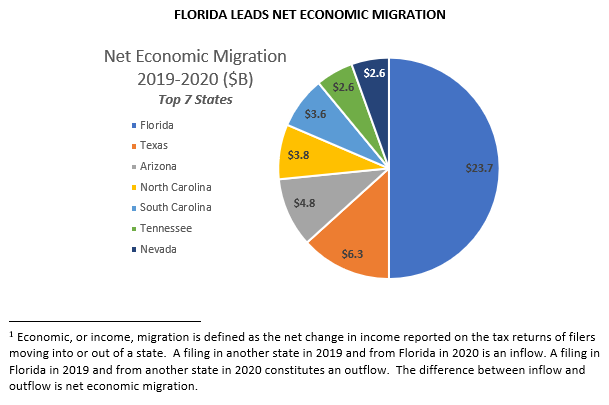Florida’s Opportunity Economy Sets National Example
Co-Authored By: Dr. Ben Tabatabaei, Florida Chamber of Commerce Chief Economist & Executive Director of the International Center for Economic Development, and Dave Sobush, CEcD, Director of Research for the Florida Chamber Foundation
You may have seen the Wallstreet Journal’s article “The Great Pandemic Wealth Migration” highlighting their take on Florida’s economic results and leadership. The Florida Chamber Foundation has been working to unite the Florida business community for decades to grow and diversify its economy. New York was the leading state of the 19th Century, California in the 20th, and Florida has emerged as the frontrunner for the 21st Century.
The Florida Chamber Foundation has adopted a bold goal to move Florida from the 15th to the 10th largest economy in the world by 2030. Under the strategic direction of the Florida 2030 Blueprint, the Florida Chamber Foundation leads the statewide efforts anchored in the Blueprint’s Six Pillars and 39 goals that will grow Florida to the top 10 by focusing on improving Florida’s talent pipeline; creating good jobs through economic diversification; preparing Florida’s infrastructure for smart growth and development; building the perfect business climate; aligned civics and governance systems; and championing a high quality of life for all Floridians.
Nationwide, over the last year, Florida created 1 out of 13 jobs and according to TheFloridaScorecard.org, is welcoming 122.4 million visitors annually. An ideal business and tax climate attracted nearly 260,000 new residents to Florida in 2021 alone, the most of any state in the nation. The Florida Chamber Foundation has been tracking economic migration[1] on TheFloridaScorecard.org for years. Based on the latest annual tax return data from the IRS, Florida attracted $23.7 billion in net economic migration; roughly $2.7 million per hour, every hour of every day.
To use a metaphor from horse racing, this was not a photo finish, more like a 31-length victory. Florida finished first, and one would need to add states #2 through #7 to reach an equal dollar value of net economic migration; the top seven states in attracting wealth through economic migration were Florida ($23.7 billion), Texas ($6.3 billion), Arizona ($4.8 billion), North Carolina ($3.8 billion), South Carolina ($3.6 billion), Tennessee ($2.6 billion) and Nevada ($2.6 billion). Of the $47.4 billion in net economic migration to these states, Florida gained approximately half (50%). In other words, economic migration to Florida was equivalent to the next six states for economic inflow combined. In fact, Florida outpaced Texas by 3.5 times – its nearest economic migration competitor during the same time frame.

Conversely, the largest net outflow of wealth came from the following states: New York ($19.5 billion); California ($17.8 billion); Illinois ($8.5 billion); Massachusetts ($2.6 billion); and New Jersey ($2.3 billion). Not surprisingly, these five states ranked near the bottom with an average ranking of 47.6 (out of 50) in the Best States for Business list compiled by CEO Magazine and an average rank of 43.4 (out of 50) in the tax climate rankings issued by the Tax Foundation. On the flip side, Florida has continued to show its leadership and strength in these same categories, ranking #2 and #4, respectively. These rankings are closely correlated with the net migration of income and Florida’s firm stance as a pro-business state with no personal income tax.
There are other metrics where we can clearly see the strength and momentum of the Florida opportunity economy: Florida collected $3.91 billion in sales and use tax revenue in May, the third-largest value ever (even when adjusted for inflation) and a broad measure of dynamic economic activity. Job creators list 603,319 open jobs in Florida, compared to 303,000 job seekers statewide. In addition, according to CompTIA, an American non-profit trade association that issues professional certifications for the information technology industry, Florida ranked second in the nation for the creation of new tech jobs, with 10,522 added; this is more than two times California, coming in at 3rd place with 5,165 added.
What has led Florida to these outcomes? Perhaps our #1-ranked colleges and universities, or maybe the top K-12 system in the southeast. The Future of Work Florida initiative – a partnership between the Florida Chamber Foundation, the Florida Department of Education, CareerSource Florida, Ready to Work Florida, and a network of local and regional institutions – promotes the nearly one hundred skilled trades occupations with strong growth prospects and earnings potential that will ensure an opportunity for earned success for every Floridian.
The Florida Chamber Foundation is proud to be leading the conversation to unite the Florida business community for good while ensuring Florida continues to enhance its quality of life and competitiveness. To that end, the Florida Chamber and its partners will continue to advocate for the right economic strategies and policies to advance the Florida 2030 Blueprint’s mission of growing Florida to a top 10 global economy; currently, Florida’s GDP is larger than Saudi Arabia’s, and we are on our way to passing South Korea. Florida is well-positioned to maintain the #1 spot for economic migration in the long term.